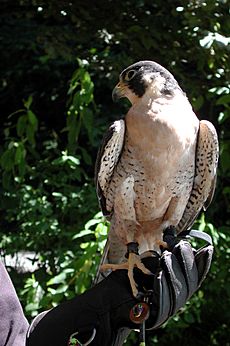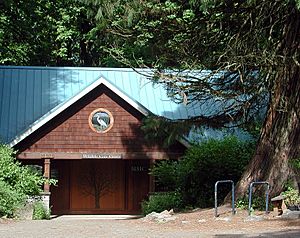Bird Alliance of Oregon facts for kids
The Bird Alliance of Oregon is a special group that works to protect birds and their homes across Oregon in the United States. It's a non-profit organization, which means it uses all its money to help its cause, not to make a profit.
This organization started way back in 1902, making it one of the oldest groups working to protect nature. In February 2024, they changed their name from Portland Audubon to Bird Alliance of Oregon. They made this change because the name "Audubon" was linked to John James Audubon, who had a racist past. They also changed "Portland" to "Oregon" to show they help birds all over the state, not just in one city.
The Bird Alliance of Oregon was first created to help set up important places like the Malheur, Klamath, and Three Arch Rocks National Wildlife Refuges. Today, they work on many important issues. These include protecting animals that are in danger, helping to fight climate change, and making sure nature is healthy for everyone to enjoy.
The Bird Alliance of Oregon has a large piece of land, about 172 acres, next to Forest Park. This land is a nature sanctuary, like a safe home for plants and animals. It has native plants and animals, including very old Douglas Fir trees. You can visit this sanctuary for free!
A stream called Balch Creek flows through much of the sanctuary. There are also more than 4 miles of hiking trails. These trails connect to the bigger trail system in Forest Park, so you can explore even more.
Inside the sanctuary, there's a nature center. It has classrooms where people can learn, a store, and exhibits with stuffed animals to show what local wildlife looks like. There's also a special wildlife care center. This center helps injured or orphaned native animals. Experts and over 100 volunteers work there. Each year, they help more than 4,000 animals get better!

Next to the care center, you can see live educational birds. These birds have injuries or were raised by humans, so they can't live in the wild on their own. They help people learn about birds up close. Right now, you might see a great horned owl and an American kestrel. There's also a western painted turtle that was saved from a pet store and now lives in a tank inside the Care Center.
In 2023, over 450 volunteers helped the Bird Alliance of Oregon. They did many jobs, like greeting visitors, fixing trails, working in the nature store, and caring for wildlife. This group is known as one of the best charities of its kind because it uses its resources very well.
People often ask the Bird Alliance of Oregon for advice. They are experts on how to help wildlife and manage natural areas.
How the Bird Alliance of Oregon Started
Bird lovers in Portland started a group called the John Burroughs Club in 1898. Then, in 1901, bird lovers in Astoria, another city in Oregon, formed the Oregon Audubon Society. In 1902, the Portland group joined them, and they all became the Oregon Audubon Society. In 1966, the name changed to Audubon Society of Portland when they joined the National Audubon Society.
This group has always worked to influence laws. They often wrote letters to leaders to make a difference. In 1903, they helped pass a law called the Model Bird Law. This law protected native birds from being hunted and sold. In 1925, they wrote letters to President Calvin Coolidge. This helped create the Hart Mountain Antelope Refuge, a safe place for antelope.
The Bird Alliance of Oregon also helped create several other national wildlife refuges. These include William L. Finley NWR, Three Arch Rocks NWR, Klamath NWR, Ankeny NWR, Baskett Slough NWR, and Malheur NWR. These refuges are important safe places for many animals.
In 2025, the Bird Alliance bought 12.5 acres of land in Northeast Portland. They plan to build a second, larger wildlife hospital there. This new center will help even more animals than their current one.
Other Interesting Topics
- List of Oregon birds
- Chapman swifts, a group of birds that rest in a school chimney each autumn. The Bird Alliance of Oregon helps protect them.


